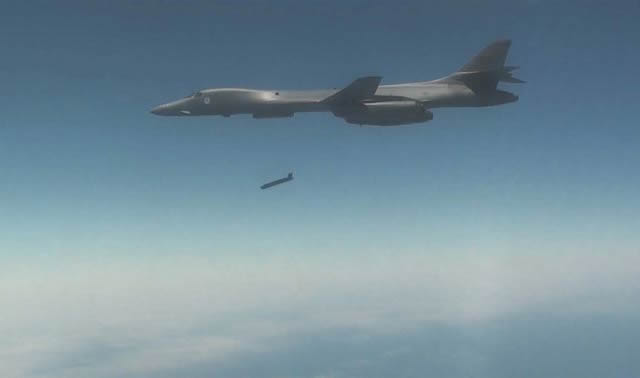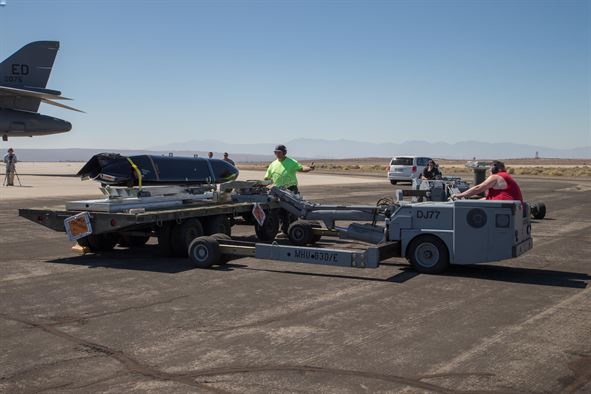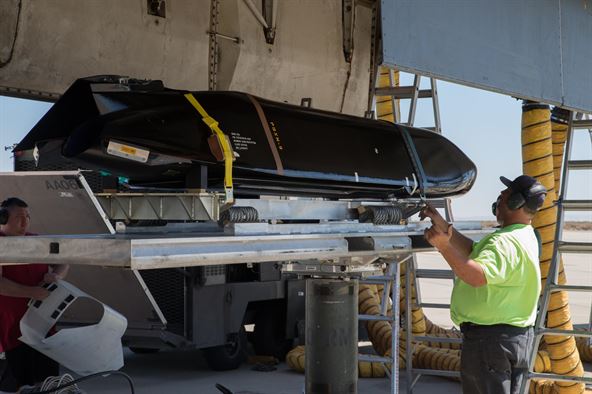|
|
|||
| a | |||
|
Naval Defense News - USA
|
|||
|
|
|||
|
Quick learning, ‘deployed mentality’ lead to AGM-158C LRASM successful launch
|
|||
|
By Kenji Thuloweit, 412th Test Wing Public Affairs
No test at Edwards can be considered simple, but when you add in numerous organizations with their own language and procedures, along with a test aircraft with engine problems, then that makes accomplishing the mission all that more challenging. But, those obstacles were overcome by the test professionals and maintainers of the 419th Flight Test Squadron who helped the U.S. Navy successfully test launch a new missile over the Point Mugu Sea Range Aug. 17. |
|||
|
|
|||
 A B-1B Lancer from Edwards Air Force launces a Long Range Anti-Ship Missile over the Point Mugu Sea Range off the coast of California Aug. 17. (U.S. Navy photo) A B-1B Lancer from Edwards Air Force launces a Long Range Anti-Ship Missile over the Point Mugu Sea Range off the coast of California Aug. 17. (U.S. Navy photo) |
|||
|
The test was the first free flight launch of the Long Range Anti-Ship Missile from an Edwards AFB B-1B Lancer. When operational, LRASM will provide the first increment of a next-generation offensive anti-surface weapon to the warfighter. The event in August marked the first end-to-end functionality test of LRASM and proved the weapon's ability to identify and prosecute a moving target at sea, according to the Navy.
The LRASM is part of a rapid acquisition program began by the Defense Advanced Research Projects Agency that was later transferred to the Navy in February 2014. The missile leverages the proven performance of the current Joint Air-to-Surface Standoff Missile airframe while incorporating several unique capabilities. “The design they based [LRASM] off of was a pre-existing weapon that had been tested on a B-1B, which is why they chose that platform,” said Kevin Butler, 419th FLTS, armament project lead engineer. “Because it’s a more advanced version of a previous weapon that is already certified, you can reduce some of the testing required.” |
|
|
|||
 Members of the 912th Aircraft Maintenance Squadron prepare to load a U.S. Navy Long Range Anti-Ship Missile on an Edwards B-1B Lancer. (U.S. Air Force photo by Don Allen) Members of the 912th Aircraft Maintenance Squadron prepare to load a U.S. Navy Long Range Anti-Ship Missile on an Edwards B-1B Lancer. (U.S. Air Force photo by Don Allen) |
|||
|
With an operational capability slated for 2018 on the B-1B, and in 2019 for the Navy’s F/A-18 Super Hornet, developmental testing of LRASM must be done relatively quickly to meet the military’s operational need on time.
“The amount of time we usually get to execute a test like this is about a couple years, but this one was pushed down to six months,” said Elvin Colindres, 412th Test Management Group, LRASM project manager. “It was a real crunch with people working a lot of overtime.” Butler explained having an increased amount of players in the test program posed additional challenges that needed to be overcome. “Just on the weapons side, there was Lockheed Martin, Boeing for the aircraft and the Navy. Being this was a joint project with the Navy, a lot of our execution was different such as the way we ran the control room and a lot of our verbiage and acronyms we used was very different — they’d say one thing and we’d thought they meant something else. All the communications with all the parties was a challenge,” Butler said. |
|||
|
|
|||
 The Long Range Anti-Ship Missile is part of a rapid acquisition program began by the Defense Advanced Research Projects Agency that was later transferred to the Navy in February 2014. The missile leverages the proven performance of the current Joint Air-to-Surface Standoff Missile airframe while incorporating several unique capabilities. (U.S. Air Force photo by Don Allen) |
|||
|
Colindres added that the maintenance and weapons teams had to learn a lot on the test project.
“One of the biggest hurdles was that everything was new, so all the technical orders for maintenance were new. There were new processes of uploading and handling of the weapon, and the weapon’s integration with the plane. We needed a lot of team players from ammo, maintenance and operations; I mean, we had tons of players,” said Colindres. Through all the learning curves, the test team pulled together and were ready to make their scheduled LRASM launch from a B-1B Aug. 16 — that is, until the bomber experienced an engine problem. “The aircraft took off and had an in-flight issue. It aborted (the test mission) and came down,” said Colindres. All tests and preparation leading up to the LRASM launch used a single B-1B from the 419th FLTS with no plan ever to use the squadron’s second Lancer for the test. Maintainers were immediately assembled and as soon as the first B-1B landed, they got to work on swapping over the missile and conducting all the preflight preparation. Something that usually takes a day-and-a-half was done within six hours, they said. “All the testing with the LRASM was always done on tail# 75, so tail# 68 was never even considered as a backup,” said Justin Anthony, 912th Aircraft Maintenance Squadron. “To go from one tail to another, when we never prepped for that; to do all that in one shift was pretty amazing.” The second B-1B took off and successfully launched LRASM off the coast of California for the Navy to further conduct their test. “One of the comments the maintainers told me is that they felt that they were back in a war-time situation, with a deployed mentality, and they all did what they had to do have mission success that day. They really pulled it off. If it weren’t for them I don’t think we would have been able to fly the next day and pull off the mission,” Anthony said. The Edwards test team will assist with three more developmental test launches of the LRASM in the near future. |
|||



